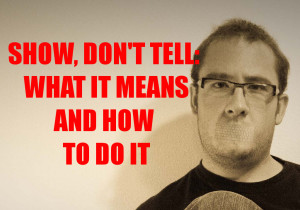Telling is claiming. Showing is proving.
Even acknowledging what I said in my last post on Show, Don’t Tell, the fact remains: when it comes to character development, “show don’t tell” translates to “actions speak louder than words.” And it’s especially important with our main characters.
For instance, I can tell you that my hero is brave and kind, but humble—but you have no reason to believe me.
I can tell you that my villain is brilliant but evil and unspeakably cruel—but you have no reason to believe me.
I can tell you that my heroine is gentle and naïve yet strong—but you have absolutely no reason to believe me.
I have made several claims, but they are nothing but opinion at best, hearsay at second best, and outright lies at the worst. I haven’t given you any proof.
The actions are the proof.
Prove bravery by making that hero scared out of his mind as he rides into battle or stands up to the bully. Prove his kindness and humility as he pretends to prefer to stand on the subway when he’s really giving up his seat to an elderly man. Show the growth of his character by upping the stakes and changing his behavior as the story progresses. What he runs from in the first chapter, make him charge at in the final chapter. What he hides from the people closest to him early on, make him bare to the world at the climax.
Prove the intelligence of your villain by making him a chess champion or a con artist or a troubled child whose parents locked him in the library to punish him. If he is a business man destroying the competing mom-and-pop store, he shouldn’t just outsell them; he should soil their reputation and win the loyalty of their customers, and know all the legal loopholes to get himself off scot-free. He should outsmart both your readers and your hero throughout the story, and when he is defeated in the end it shouldn’t be because he made a stupid mistake. Prove evil and cruelty by making him abuse an old man, a little girl, his wife. Have him murder his best friend or his brother.
Prove the gentleness of your heroine by making her go out of her way to set a mouse free instead of killing it. Prove her naivety by having her trust the villain when he says he’s trying to turn his life around. And prove her strength by making her fight her own battle; she’s the one digging up legal proof of the villain’s guilt while the hero is out sparring with his lackeys in alley ways. Or she’s the queen trying to stifle a political coup while the king is away at war.
If there is any character trait you want to convey, give that character something that tests that area. Give them a chance to show who they are. Make a patient man wait years for his girlfriend to say yes to a ring. Make a determined woman who has just escaped slavery face poverty and discrimination and sickness before she finds her happiness.
Then, your readers will not only believe that your hero is brave, your villain is evil, and your heroine is strong—they will argue with you if you try to tell them otherwise. That is the power of Show, Don’t Tell.
—
Read more!
How to get rid of background exposition
—




